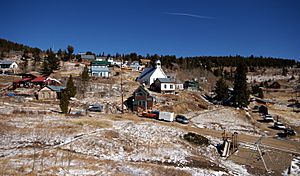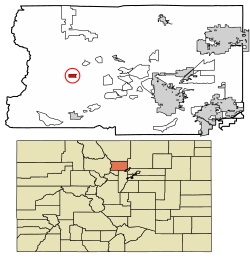Ward, Colorado facts for kids
Quick facts for kids
Ward, Colorado
|
|
|---|---|
 |
|

Location of Ward in Boulder County, Colorado.
|
|
| Country | |
| State | |
| County | Boulder County |
| Founded | 1860 |
| Incorporated | June 9, 1896 |
| Government | |
| • Type | Home rule municipality |
| Area | |
| • Total | 1.39 km2 (0.54 sq mi) |
| • Land | 1.39 km2 (0.54 sq mi) |
| • Water | 0.00 km2 (0.00 sq mi) |
| Elevation | 2,884 m (9,462 ft) |
| Population
(2020)
|
|
| • Total | 128 |
| • Density | 116.08/km2 (300.37/sq mi) |
| Time zone | UTC-7 (Mountain (MST)) |
| • Summer (DST) | UTC-6 (MDT) |
| ZIP code |
80481
|
| Area code(s) | 303 |
| FIPS code | 08-82735 |
| GNIS feature ID | 2413449 |
Ward is a small town in Boulder County, Colorado, United States. It is a special type of town called a home rule municipality. In 2020, the town had 128 people living there.
Ward started as a mining settlement in 1860. This was after gold was found nearby at Gold Hill. During the Colorado Gold Rush, Ward was one of the richest towns in the state. It is located high up on a mountainside. You can find it at the top of Left Hand Canyon, near the Peak to Peak Highway (State Highway 72). Ward is northwest of Boulder and sits at about 9,450 feet (2,880 meters) above sea level.
History of Ward
The town of Ward was named after Calvin Ward. He was a prospector (someone who searches for minerals) who found a claim in 1860. This spot was called Miser's Dream. The town grew very quickly the next year. This happened after Cyrus W. Deardorff discovered the Columbia vein, which was rich in minerals.
Over many years, the number of people living in Ward changed a lot. It grew from a few hundred to several thousand, then went down again. The mines in the area made money for many decades. One mine even produced over 2 million ounces (57 metric tons) of silver!
A post office opened in Ward in 1863. The town officially became a city in June 1896. A railroad reached Ward in 1898. It climbed over 4,000 feet (1,219 meters) from Boulder over 26 miles (42 kilometers).
In January 1900, a big fire destroyed more than 50 buildings. But because the mines were still making money, the town was rebuilt right away. By the 1920s, most people had left Ward. However, the building of the Peak-to-Peak Highway in the 1930s helped the town come back to life. During World War II, only four people lived in Ward year-round. Then, in the 1960s, the population grew again. It jumped from 10-20 people to over 100. This was because the town became popular with people known as hippies.
Today, Ward has a few businesses on its main street. These include a restaurant, a coffee shop, an art gallery, and a general store.
Ward's Geography
Ward is a small town. According to the United States Census Bureau, the town covers about 0.6 square miles (1.6 square kilometers). All of this area is land.
Ward's Population
| Historical population | |||
|---|---|---|---|
| Census | Pop. | %± | |
| 1890 | 424 | — | |
| 1900 | 300 | −29.2% | |
| 1910 | 129 | −57.0% | |
| 1920 | 74 | −42.6% | |
| 1930 | 34 | −54.1% | |
| 1940 | 118 | 247.1% | |
| 1950 | 10 | −91.5% | |
| 1960 | 9 | −10.0% | |
| 1970 | 32 | 255.6% | |
| 1980 | 129 | 303.1% | |
| 1990 | 159 | 23.3% | |
| 2000 | 169 | 6.3% | |
| 2010 | 150 | −11.2% | |
| 2020 | 128 | −14.7% | |
| U.S. Decennial Census | |||
In 2010, there were 150 people living in Ward. There were 75 households. A household is a group of people living together in one home. About 27% of these households had children under 18. About 35% were married couples.
The average number of people in a household was 2. The average family size was 2.67 people. The town's population had people of all ages. About 19% were under 18. About 35% were between 45 and 64 years old. The median age was 43.5 years. This means half the people were younger and half were older than 43.5.
In 2000, the average income for a household in Ward was $33,750. For a family, it was $50,313. The average income per person in the town was $14,900. No one in Ward was living below the poverty line at that time.
Notable People from Ward
- Hazel Schmoll, a famous botanist (someone who studies plants).
See also
 In Spanish: Ward (Colorado) para niños
In Spanish: Ward (Colorado) para niños



